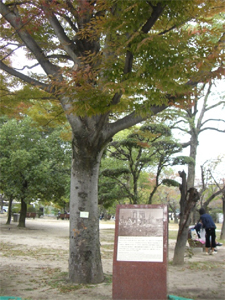
Overview of Nakajima District
Nakajima District, the Peace Memorial Park area, is a historical town that prospered as one of the foremost downtown areas in Japan from the end of the Edo Era through the Meiji, Taisho and Showa Eras.
Located in the delta between the Motoyasu and Hon Rivers, the district comprises such areas as Nakajima-honmachi, Tenjin-machi, Zaimoku-cho, Kobiki-cho, Motoyanagi-cho, Nakajima-shinmachi and Kako-machi.
The A-bomb, dropped for the first time in the history of humankind on August 6, 1945, exploded over the Nakajima District. Not only residents of the district, but also many National Militia Unit members and mobilized students, who were engaged in clearing abandoned buildings in the vicinity at the time of the A-bombing, died a violent death, and the cityscape instantly vanished.
Noteworthy characteristics
- Population and Main Buildings Before the A-bombing
- Nakajima-honmachi
- Tenjin-machi
- Zaimoku-cho & Kobiki-cho
- Motoyanagi-machi
- Nakajima-shinmachi
- Kako-machi
The total population of the seven areas is estimated to have been 6,500.
As for main buildings, the district comprises the Nakajima Market, Nakajima Kanshoba (bazaar), public markets, Prefectural Office, Butokuden, Prefectural Hospital, Nakajima Primary School, Jisenji Temple and Seiganji Temple.
The area was very crowded with an array of shops and movie theaters standing closely side by side, as in Asakusa Nakamise in Tokyo, as well as temples, Japanese-style restaurants, draper's shops, clinics, drugstores and companies.
The area was called "Funamachi (ship town)" in olden times, partly because travelers and goods moved briskly in and out on river barges that flocked along the riverbanks. Over time, the area came to be called "Tenjin-machi," with Tenmangu Shrine built in the area.
These were areas where lumber was stacked along the riverbanks. Barges and rafts loaded with timber traveled down the Ota River and unload here. Although these areas ultimately became desolate as land transport rapidly developed in the Taisho Era, the spacious and comfortable residential districts expanding into Nakajima-honmachi provided the peaceful atmosphere of an old downtown dotted with historical temples, including Seigan Temple, where many pigeons flocked.
As described in the valued book collection "Chishin-shu," "A huge ancient willow spread its roots in the riverbank"; this area was thus called Motoyanagi-machi (original willow town), from which derived the name Higashiyanagi-machi (east willow town; present-day Inari-cho, Minami-ku). Motoyanagi-machi was a cozy little town facing the Hon River.
This area, called Shinmachi Street in olden days, later became Nakajima-shinmachi. It had been the center of municipal administration with the City Hall and City Chamber established there during the Meiji Era, until they were moved to their current location, Kokutaiji-cho, at the beginning of the Showa Era.
This area, a historic town from the old clan-period, comprised an affluent residential neighborhood of refined atmosphere around the Prefectural Office.
Related Information:Monument of the Former North Tenjin-machi Area、Monument to the Former Zaimoku-cho、Monument of the Former South Tenjin-machi Area